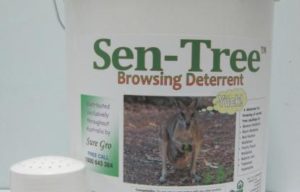
Browsing native animals such as kangaroos, wallabies, and possums and introduced browsing animals like hares and rabbits will not feed on either of the two main Leptospermum species discussed here, once they are well established, even in periods of extreme drought and shortages of their usual feed.
These animals, with their territorial instincts, may usually browse newly transplanted seedlings out of curiosity at seeing something new in their immediate environment/territory.
But after that, the astringency of the oil in the foliage along with the prickly foliage (particularly in the case of L. scoparium) deters them from any major browsing in the medium to long-term.
In some instances birds, in particular, magpies will lift newly-planted seedlings out of the ground.
When damage occurs to new plantings, it can often be difficult to identify the culprit. I can recommend the use of wildlife cameras to resolve this issue.
Having said that, if the browsing pressure is intense then some exclusion control or proper protection measures will be required immediately after planting out and kept in place for a period of time to allow the plants to develop somewhat. This may be for 18 months or so rather than years.
Observation over a number of years indicates that Wallabies are the major offenders. Kangaroos tend to prefer grazing on grasses while wallabies prefer to browse shrubs and tufty plants (including Leptospermum seedlings). Swamp or black wallabies occur all over eastern Australia and usually are solitary animals.
If the browsing pressure is unacceptably high, then using a deterrent should be considered. One such deterrent is a product is called Sen-Tree developed in Victoria for the protection of newly planted trees and shrubs.

This is a two-part application applied to seedling stock before planting. It is an egg-based adhesive compound, added to an adhesive polymer. This is then sprayed onto the foliage of the plant. Once semi-dry (tacky) sprinkled the Silicone Carbide grit is shaken onto the foliage. The combination of odour and grit has a recurring deterrent effect through learned association. It seems that the treatment will last long enough for the browsing animals to lose interest before new unprotected growth emerges.
I have used this product on three properties in the last year and found it to be highly effective. ERA Nurseries routinely applies this treatment to tube stock destined for high browsing risk properties before dispatch.
Flocks of native birds such as Corellas may also do some damage also out of curiosity. In these cases, they tend to bite the stem off above the ground, and no doubt will lose interest in doing it again. This almost always happens soon after planting and diminishes soon after.

Should this happen, the plants will usually produce new shoots below the point where the stem was damaged.
If this becomes an issue, then there is a range of bird scaring devices available that will do the job.
Ever wondered what happens when you are not around? Check out this short video!
https://www.leptospermum.com.au/wp-content/uploads/2022/06/Teddy-Bears-Picnic.wmv